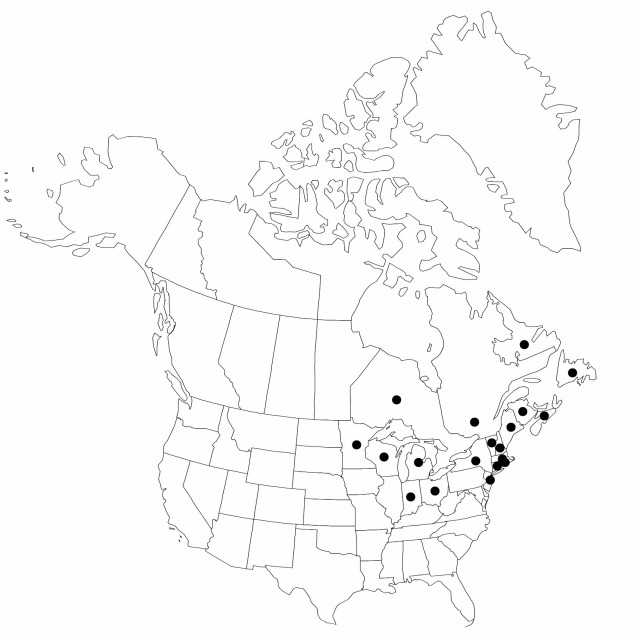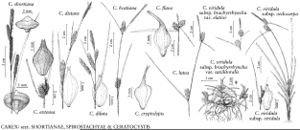Carex cryptolepis
Torreya 14: 157. 1914.
Plants cespitose. Culms straight, 10–50 cm, tallest ones 25–50 cm. Leaves of flowering-stems usually shorter than culms, 5–20 cm × 1.5–2.9 mm; ligules on distal cauline leaves truncate or rounded. Inflorescences: peduncles of terminal staminate spikes 0.5–8 mm, 0.2–0.5 length of staminate spikes; bracts to 20 cm × 1.1–2.9 mm, 1.5–4 times as long as inflorescences; inner band of sheaths concave or truncate. Spikes: proximal pistillate spikes (1–) 2–5, approximate, subsessile or short-pedunculate, globose to elliptic, 8.5–19.9 × 4.1–9.8 mm; terminal staminate spikes pedunculate, 12–21 × 1.3–2.7 mm. Scales: pistillate scales yellowish green, inconspicuous among perigynia, 1.7–2.6 × 0.8–1.2 mm; staminate scales yellowish green, ovate, 2.9–4.4 × 0.8–1.6 mm, apex obtuse or acute to acuminate. Anthers 1.1–2.9 mm. Perigynia reflexed, yellowish green, 3.5–4.8 × 1.1–1.7 mm, apex gradually narrowed; beak 1.4–2.5 mm, forming an angle of 13–48° with body, smooth. Achenes 1.2–1.5 × 1–1.2 mm. 2n = 64.
Phenology: Fruiting Jun–Aug.
Habitat: Acidic, sandy or organic substrates on open, emergent shorelines, not found on lime-rich soils
Elevation: 0–500 m
Distribution

N.B., Nfld. and Labr., N.S., Ont., Que., Conn., Ind., Maine, Mass., Mich., Minn., N.H., N.J., N.Y., Ohio, R.I., Vt., Wis.
Discussion
The name Carex flava var. fertilis Peck has been misapplied to C. cryptolepis.
Selected References
None.
Lower Taxa
"shortened" is not a number.No values specified."lengthofstaminatespikes" is not declared as a valid unit of measurement for this property. "lengthofstaminatespikes" is not declared as a valid unit of measurement for this property.
